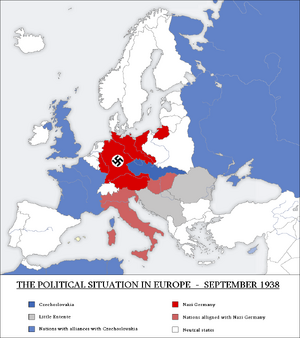
A list of several nations in the timeline of Fall Grün that are different than in our timeline in one way or another.
Nations belonging to the Little Entente[]
The Little Entente was an alliance formed in 1920 and 1921 by Czechoslovakia, Romania and Yugoslavia with the purpose of common defense against Hungarian irredentism and the prevention of a Habsburg restoration. France supported the alliance by signing treaties with each member country. However, the Little Entente began to break down in 1936 and disbanded completely in 1938. France had seen the Little Entente as an opportunity, in the interests of French security, to revitalize the threat of a two-front war against Germany.
| Nations | |||||||||||||
|---|---|---|---|---|---|---|---|---|---|---|---|---|---|

|
Republic of Czechoslovakia | ||||||||||||

|
Kingdom of Romania | ||||||||||||

|
Kingdom of Yugoslavia | ||||||||||||
Nations with alliances with Czechoslovakia[]
The Treaty of Alliance and Friendship between France and Czechoslovakia, signed on January 25, 1924 in Paris. The treaty was concluded for an unlimited time. In case of Czechoslovakia should be invaded by Germany, France was obliged to support their Czechoslovak ally by attacking Germany from the West.
In 1935 the Soviet Union signed treaties with France and Czechoslovakia. In essence, the treaties provided that the Soviet Union would come to Czechoslovakia's aid only if French assistance came first.
| Nations | |||||||||||||
|---|---|---|---|---|---|---|---|---|---|---|---|---|---|

|
French Third Republic | ||||||||||||

|
United Kingdom | ||||||||||||

|
Soviet Union | ||||||||||||
Nations belonging to the Rome-Berlin Axis[]
Tensions between Nazi Germany and Mussolini's Italy rose in 1934 as the Nazis attempted a coup d'ètat in neighbouring Austria. However, on October 25, 1936, the Treaty of friendship is signed between Italy and Nazi Germany when Italy, originally opposed to Germany, was faced with opposition to its war in Abyssinia from the League of Nations and received support from Germany. Mussolini declared that the two countries would form an "axis" around which the other states of Europe would revolve. Later, in May 1939, this relationship transformed into an alliance, called by Mussolini the "Pact of Steel".
| Nations | |||||||||||||
|---|---|---|---|---|---|---|---|---|---|---|---|---|---|

|
German Reich | ||||||||||||

|
Kingdom of Italy | ||||||||||||
Nations aligned with the Axis[]
Initially, despite a move back towards nationalism, the new state under Regent Horthy agreed to ending the chance for further immediate conflicts and signed the Treaty of Trianon on June 4, 1920. Trianon reduced Hungary’s size substantially from its size in Austria-Hungary. Transylvania was taken by Romania; Slovakia became part of Czechoslovakia; Croatia, Slavonia, and Vojvodina joined the Kingdom of Serbs, Croats, and Slovenes (Yugoslavia after 1929).
With the succession of increasingly nationalist and far-right Prime Ministers, Hungary steadily moved to opposing the Treaty of Trianon and established ties with the dictatorships of Nazi Germany and Fascist Italy. Seeing that if aligning themselves with Nazi Germany, they could secure their national, political and territorial interests.
| Nations | |||||||||||||
|---|---|---|---|---|---|---|---|---|---|---|---|---|---|

|
Kingdom of Hungary | ||||||||||||
Neutral States[]
During the Sudeten crisis and the following invasion of Czechoslovakia, the majority of the nations in Europe declared their neutrality, hoping to avoid being dragged into the confict. However, some nations declared their neutrality, but nevertheless participated in the conflict to secure their national and political interests.
| Nations | |||||||||||||
|---|---|---|---|---|---|---|---|---|---|---|---|---|---|

|
Second Polish Republic | ||||||||||||
